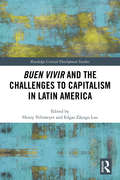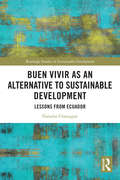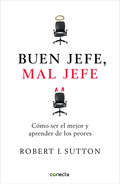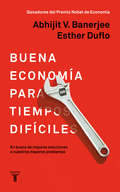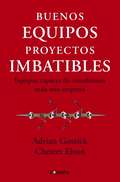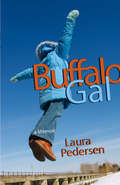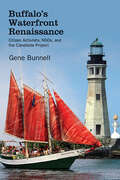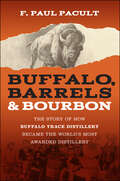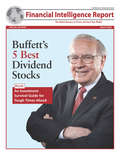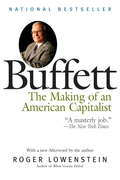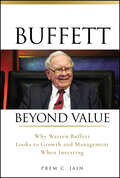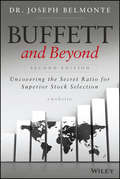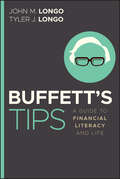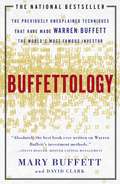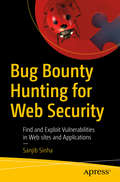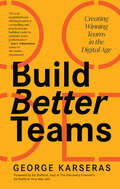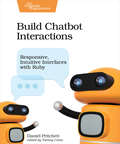- Table View
- List View
Buen Vivir and the Challenges to Capitalism in Latin America (Routledge Critical Development Studies)
by Henry Veltmeyer Edgar Zayago LauThis book explores the battleground between neoliberal capitalist development processes in Latin America and the challenges to these systems that can be found through innovative community-driven buen vivir/vivir bien initiatives. In the current climate of worldwide capitalist development, Latin America is caught between left-leaning proposals for progressive policies towards a more inclusive form of development, and the re-emergence of harsh austerity measures, neoliberal reforms and right-wing populism. Divided into two parts, this book first provides a retrospective analysis of the advance of resource-seeking ‘extractive’ capital across the continent since the 1990s. The second part goes on to focus on forward-looking challenges to neoliberal capitalist development, focusing in particular on the indigenous notion of buen vivir/vivir bien – the concept of ‘living well’ in social solidarity and harmony with nature. Drawing on cases in Mexico and Venezuela, the book argues that it will be through these new approaches to social change that we will move beyond development as we know it towards a more inclusive form of ‘postdevelopment’. Looking hopefully towards this future of development, this collection offers an essential analysis of the vortex of social change currently consuming Latin America and will be key reading for advanced scholars and researchers in the fields of Development Studies, Latin America Studies, Politics, and Social Change.
Buen Vivir as an Alternative to Sustainable Development: Lessons from Ecuador (Routledge Studies in Sustainable Development)
by Natasha ChassagneUntil recently, the concept of Buen Vivir has only been loosely articulated by practising communities and in progressive policy in countries like Ecuador. What it actually means has been unclear, and in the case of policy, contradictory. As such there has been a lack of understanding about exactly what Buen Vivir entails, its core principles and how to put it into practice. This book, based on extensive theoretical and field research of Buen Vivir as an alternative to sustainable development, fills that gap and offers a concrete way forward. It uses an ethnographic study in the Cotacachi County of Ecuador's highlands communities to explore how communities understand and practice Buen Vivir. Combining this with what we already know about the concept theoretically, the book then develops a framework for Buen Vivir with 17 principles for practice. Exploring Buen Vivir’s evolution from its indigenous origins, academic interpretations and implications for development policy; to its role in endogenous, community-led change, this book will be of interest to policymakers, and development professionals. It will also be of great value to activists, students and scholars of sustainability and development seeking grassroots social and environmental change.
Buen jefe, mal jefe
by Robert I. SuttonEl coste de los jefes ineptos y agresivos es enorme; sus equipos trabajan más torpemente, cometen errores, e incluso sufren más problemas cardiacos. A partir de numerosos casos y ejemplos de las más variadas empresas, Sutton muestra cómo los mejores jefes crean entornos de trabajo eficaces y humanos.Buen jefe, mal jefe representa una herramienta única para todos aquellos que han recibido la responsabilidad de dirigir a otras personas, y una tabla de salvación para quienes tienen la desgracia de soportar a un jefe que no está a la altura.«Solo el esquema titulado "jefes inteligentes frente a jefes sabios" justifica cien veces el precio del libro. Buen jefe, mal jefe es altamente recomendable.»Tom Peters, autor de En busca de la excelencia
Buen jefe, mal jefe: Cómo ser el mejor y aprender de los peores
by Robert I. Sutton¿Es usted un buen jefe? Si sus empleados pudieran escoger, ¿seguirían trabajando con usted? Y sobre todo, ¿tiene idea de cómo se siente su equipo? Robert I. Sutton plantea lo que todo jefe debería aprender de los mejores y de los peores. El coste empresarial de los jefes ineptos y agresivos es enorme: sus equipos trabajan de manera más torpe, cometen más errores e incluso sufren más problemas cardíacos. A partir de numerosos casos y ejemplos de las más variadas empresas, Sutton muestra cómo los mejores jefes crean un entorno de trabajo eficaz y humano. Buen jefe, mal jefe representa una herramienta única para todos aquellos que han asumido la responsabilidad de dirigir a otras personas, y una tabla de salvación para quienes tienen la desgracia de soportar a un jefe que no está a la altura. Reseñas:«Buen jefe, mal jefe se ha convertido en mi libro de negocios dereferencia. Ofrece numerosos principios y propuestas, refrendados por casos reales; todo jefe debería leerlo y asimilarlo.»John Lilly, CEO de Mozilla Corporation «Somos muy afortunados de contar con Bob Sutton. Cada una de sus afirmaciones está apoyada sobre sólidas investigaciones. Solo su esquema titulado "Jefes inteligentes frente a jefes sabios" justifica cien veces el precio del libro. Buen jefe, mal jefe es altamente recomendable.»Tom Peters, autor de En busca de la excelencia «Buen jefe, mal jefe contiene material de reflexión para directivos de empresas y líderes de organizaciones, tanto grandes como pequeñas. Es un libro con numerosas ideas, propuestas prácticas y cuestiones útiles para todos los jefes.»Reuters
Buena economía para tiempos difíciles: En busca de mejores soluciones a nuestros mayores problemas
by Abhijit Banerjee Esther DufloEl nuevo libro de los premios Nobel de Economía Banerjee y Duflo, autores de Repensar la pobreza. «No todos los economistas llevan corbata y piensan como banqueros. De lectura obligada.»Thomas Piketty En este libro refrescante e ideal para el momento que vivimos, los premios Nobel Duflo y Banerjee descubren al lector hasta qué punto la economía, cuando se ejerce bien, puede resolver nuestros problemas sociales y políticos más acuciantes. Tenemos los recursos para afrontar todos los retos, de la inmigración a la desigualdad o a la emergencia climática, pero la ideología nos ciega con demasiada frecuencia. ¿Por qué las migraciones no siguen las leyes de la oferta y la demanda? ¿Por qué la liberalización del comercio puede aumentar el desempleo y bajar los salarios? ¿Por qué nadie ha logrado explicar de manera convincente las condiciones necesarias para el crecimiento? Las experiencias de las últimas décadas no han ofrecido una imagen amable de los economistas: dormidos al volante (con el pie en el acelerador) en el periodo previo a la gran recesión, discutiendo después sobre cómo salir de ella, o haciendo oídos sordos a las voces de alarma sobre la difícil situación de Grecia o la zona euro, parecen haber perdido la capacidad de orientarnos. Sin embargo, Duflo y Banerjee defienden el papel de los economistas, así como el intervencionismo inteligente y la búsqueda de una sociedad basada en la empatía y el respeto. Este libro es un verdadero antídoto contra el discurso polarizado. La crítica ha dicho...«Dos de los economistas actuales más perspicaces, con una gran habilidad para volver la economía accesible a la gente corriente, abordan la desigualdad, la polarización política y los debates más acuciantes en los países ricos.» BILL GATES «Un gran logro, y un libro perfecto para nuestro tiempo. Ilumina los más grandes problemas del momento, incluidos la inmigración, el cambio climático y la desigualdad.»Cass R. Sunstein «Un excelente antídoto contra las formas más peligrosas de golpe económico. Duflo y Banerjee escriben maravillosamente y tienen pleno dominio de su tema. Quizá su mayor contribución consiste en mostrar tanto ideas brillantes que la economía convencional nos ofrece como sus límites, y que un internacionalismo progresista tiene el deber de trascender.»Yanis Varoufakis, The Guardian «Lúcido y a menudo sorprendente. Sus argumentos son originales y propios de mentes abiertas, y sus pruebas están claramente expuestas. Revelador.»Publishers Weekly «Una defensa convincente de que hasta qué punto la economía ofrece respuestas a muchos problemas graves, desde el populismo hasta la política de identidad, especialmente cuando los economistas están dispuestos a ir más allá de los límites de su disciplina.» Financial Times «Excelente. Pocos han lidiado tan enérgicamente con la complejidad de la vida real como lo han hecho Duflo y Banerjee. Cautivará a los lectores con su enorme intelecto y su atractiva modestia.»The Economist «Respaldado en sólidos argumentos y una minuciosa investigación. Una defensa convincente de la economía empírica como fuente de respuestas a los problemas más engorrosos.»Publishers Weekly «Un libro a la altura de la reputación de sus autores que ofrece un recorrido magistral por la evidencia actual sobre cuestiones críticas de política.»William Easterly, The Wall Street Journal
Buenos Aires Embotelladora S.A. (BAESA): A South American Restructuring
by Gustavo A. Herrero Stuart C. GilsonIn 1998, BAESA, PepsiCo's largest bottler and distributor outside North America, experienced severe financial difficulty and had to restructure its debt and business operations to avoid bankruptcy or liquidation. Based in Argentina, with operations throughout South America, the company had for years been a spectacular success story and media darling, until it undertook an ill-fated expansion in Brazil. The company's debt was owed to banks and financial institutions in South America, Asia, Europe, and the United States. In addition, the company had $60 million of publicly traded bonds, much of them held by U.S. investors. The restructuring was the largest and most complicated undertaking of its kind ever taken in South America. In addition to negotiating with its bankers and making a public exchange offer for its bonds, the company made a massive common stock rights offering to its shareholders, giving them the opportunity to purchase new stock in the company. It also considered filing a "prepackaged" Chapter 11 bankruptcy in the United States to pressure U.S. bondholders to go along with the plan. The negotiations were greatly complicated by differences in the bankruptcy laws of Argentina, Brazil, and the United States.
Buenos equipos, empresas imbatibles: Equipos capaces de transformar toda una empresa
by Adrian Gostick Elton ChesterUn equipo que despliega plenamente su potencial es capaz de revolucionar toda una empresa. Descubra cómo se desarrolla este tipo de equipos de alto rendimiento, comprometidos y que comparten la misma pasión y una visión común. Las investigaciones de Elton Chester y Adrian Gostick demuestran que el auténtico éxito duradero se fundamenta en un tipo de equipo de alto rendimiento formado por personas comprometidas que comparten la misma pasión y una visión común. A partir de una exhaustiva investigación de equipos excepcionales en empresas de diferentes sectores, los autores han condensado las características y dinámicas que los unifican, dando lugar a una energía desbordante y a unos resultados extraordinarios. Una guía única para forjar equipos rompedores, y desatar la pasión y la visión de una auténtica revolución. Los expertos opinan:«Este libro es la clave para lograr el máximo rendimiento de sus equipos. Está llamado a convertirse en un clásico.»Dave Ulrich, profesor de la Ross School of Business, Universidad de Michigan y autor del best seller Liderazgo basado en resultados «Buenos equipos, proyectos imbatibles debería ser una lectura obligada para todo líder que desee desplegar plenamente el potencial de sus equipos y crear una corriente constante de alto rendimiento.»David Kasiarz, vicepresidente de American Express «Realmente rompedor, Gostick y Elton descubren una nueva dimensión para el desarrollo de grandes equipos. ¡Este libro le permitirá lograr grandes resultados!»Marshall Goldsmith, coach ejecutivo, autor de Un nuevo impulso «Este libro es capaz de cambiar su empresa; le muestra cómo formar equipos únicos que consigan conquistar a sus clientes, empleados y vendedores.»Tony Hsieh, CEO de Zappos.com
Buenos modales. Buenos negocios: Protocolo en la empresa de hoy
by Edith CortelezziUn libro necesario para todo aquel que quiera sobrevivir y destacarse en el ambiente empresarial y social con el conocimiento de las reglas protocolares como herramienta. En el mundo de hoy -donde todo es rápido y vertiginoso- el éxito tanto en el ámbito empresarial como social nos exige estar lo más preparados que nos sea posible. A la hora de buscar trabajo o de desempeñarse satisfactoriamente en el ámbito laboral, las personas no tienen dudas acerca de la importancia de contar con un título universitario, cursos y posgrados que garanticen y realcen sus destrezas. En este contexto, ciertos atributos que parecen pasados de moda deben ser reafirmados. Uno de ellos es el protocolo. La primera intención de este libro es desmitificar la idea de que el protocolo solo es para diplomáticos. Nada más alejado. Muchas veces no sabemos expresar lo que queremos decir, nos ganamos por torpeza la antipatía de otros, hablamos cuando deberíamos hacer silencio o nos callamos cuando están esperando una respuesta de nuestra parte. Otras veces, el desconocimiento de las formas nos hace trastabillar en los momentos clave. Saber comportarse en todas las circunstancias es un arte que puede aprenderse y nos llevará directo al éxito. Este libro brinda toda la información necesaria para desenvolvernos en situaciones complejas. A través del manejo y el cuidado de los modales, otorga la seguridad necesaria para negociar con un cliente, convivir cordialmente con nuestros pares y ser justos con nuestros subalternos. Nos da herramientas para mantener una conversación interesante, saber mirar a nuestro interlocutor, asistir a una cena o ser un buen invitado. Con un lenguaje ameno y descontracturado, Edith Cortelezzi nos demuestra que todo es posible cuando se conocen las reglas.
Buenos modales. Mejores negocios: Cómo desenvolverse con éxito dentro y fuera de la empresa
by Edith CortelezziUn libro necesario para todo aquel que quiera sobrevivir y destacarse en el ambiente empresarial y social con el conocimiento de las reglas protocolares como herramienta. En el mundo de hoy -donde todo es rápido y vertiginoso- el éxito tanto en el ámbito empresarial como social nos exige estar lo más preparados que nos sea posible. A la hora de buscar trabajo o de desempeñarse satisfactoriamente en el ámbito laboral, las personas no tienen dudas acerca de la importancia de contar con un título universitario, cursos y posgrados que garanticen y realcen sus destrezas. En este contexto, ciertos atributos que parecen pasados de moda deben ser reafirmados. Uno de ellos es el protocolo. La primera intención de este libro es desmitificar la idea de que el protocolo solo es para diplomáticos. Nada más alejado. Muchas veces no sabemos expresar lo que queremos decir, nos ganamos por torpeza la antipatía de otros, hablamos cuando deberíamos hacer silencio o nos callamos cuando están esperando una respuesta de nuestra parte. Otras veces, el desconocimiento de las formas nos hace trastabillar en los momentos clave. Saber comportarse en todas las circunstancias es un arte que puede aprenderse y nos llevará directo al éxito. Este libro brinda toda la información necesaria para desenvolvernos en situaciones complejas. A través del manejo y el cuidado de los modales, otorga la seguridad necesaria para negociar con un cliente, convivir cordialmente con nuestros pares y ser justos con nuestros subalternos. Nos da herramientas para mantener una conversación interesante, saber mirar a nuestro interlocutor, asistir a una cena o ser un buen invitado. Con un lenguaje ameno y descontracturado, Edith Cortelezzi nos demuestra que todo es posible cuando se conocen las reglas.
Buffalo Gal
by Laura PedersenThis vibrant memoir about growing up in upstate New York during the 1970s shares the humorous ups and downs of the Pedersen family. Combining laugh-out-loud humor with a genuine slice of social history, New York Times writer Laura Pedersen paints a vivid portrait of an era.
Buffalo's Waterfront Renaissance: Citizen Activists, NGOs, and the Canalside Project (Excelsior Editions)
by Gene BunnellThis book tells the remarkable story of howBuffalo's post-industrial waterfront was reclaimed for public use and enjoyment and pays tribute to the many local citizens and nongovernmental organizations that made the city’s waterfront renaissance possible. After years of litigation, public controversy and debate, preservationists and environmentalists ultimately succeeded in persuading the state to abandon its contentious plans for privately developing Buffalo's waterfront. Gene Bunnell, an experienced urban planner, lays out the Buffalo waterfront's long and troubled history, from the torrent of shipping and commercial activity that was unleashed by the opening of the Erie Canal, to the contamination of the Buffalo River due to waterside industries, to how the Outer Harbor—the last portion of the waterfront to be industrially developed—was reshaped and contaminated by filling in low-lying areas with a toxic mix of waste materials. Drawing on interviews and articles, editorials, and op-eds from The Buffalo News, Bunnell provides the reader with a "real-time" sense of how the struggle over the future of Buffalo's waterfront unfolded and the ultimate victory by local activists to secure environmental cleanup, restored natural habitats, and expanded public waterfront access.
Buffalo, Barrels, & Bourbon: The Story of How Buffalo Trace Distillery Became The World's Most Awarded Distillery
by F. Paul PacultLearn about one of the most impactful distilleries in American history in this comprehensive tale Buffalo, Barrels, & Bourbon tells the fascinating tale of the Buffalo Trace Distillery, from the time of the earliest explorations of Kentucky to the present day. Author and award-winning spirits expert F. Paul Pacult takes readers on a journey through history that covers the American Revolutionary War, U.S Civil War, two World Wars, Prohibition, and the Great Depression. Buffalo, Barrels, & Bourbon covers the pedigree and provenance of the Buffalo Trace Distillery: The larger-than-life personalities that over a century and a half made Buffalo Trace Distillery what it is today Detailed accounts on how many of the distillery’s award-winning and world-famous brands were created The impact of world events, including multiple depressions, weather-related events, and major conflicts, on the distillery Belonging on the shelf of anyone with an interest in American spirits and history, Buffalo, Barrels, & Bourbon is a compelling must-read.
Buffer.com
by Brian J. Hall Tiffany Y. Chang Susanna Gallani Jee Eun ShinSocial media company, Buffer, wanted to establish clear company values early in its growth. One of these values was a commitment to transparency in its company practices. Buffer openly shared its business strategies and fundraising decks, among lots of other information. Even when they were hacked, the company live-blogged updates to keep their users informed as the situation unfolded. Having internally released each employee's salary and equity details with no pushback, the company now comtemplated sharing compensation information transparently with the general public.
Buffer.com (B)
by Brian J. Hall Tiffany Y. Chang Susanna Gallani Jee Eun ShinBuffer decided to release its salaries and compensation calculation formula to the public, and the public reaction was greater and more positive than they would have imagined. The company experienced both an increase in volume and a change in the kinds of inbound applications they received. As the company continued to grow, Buffer's senior leaders continued to revise the compensation formula based on feedback both internally and from the public. Particularly, they hoped to strengthen the link between pay and performance, which in the current version of the formula was incorporated using a loosely defined "experience level" component. However, defining clear performance metrics and experience levels was not an easy task.
Buffet's 5 Best Dividend Stocks
by Newsmax MediaThe investment analysts at Newsmax Finance scoured the documents of Buffett's holding company, Berkshire Hathaway, and investigated what Buffett is saying about the companies that he's investing in. Based on this, our analysts picked from Buffett's stock portfolio the "5 best dividend stocks" to invest in. They found the stocks that offered higher-than-usual dividend income and had not fully appreciated, making these newer additions to the investment mogul's portfolio extraordinary picks.These 5 stocks should be the core holdings for investors looking to weather any storm and significantly build their wealth along the way. This 27-page report also gives an investment survival guide to navigate the tough times ahead as our nation faces the threat of massive inflation due to the Federal Reserve's quantitative easing programs.
Buffett
by Roger LowensteinSince its hardcover publication in August of 1995, Buffett has appeared on the Wall Street Journal, New York Times, San Francisco Chronicle, Los Angeles Times, Seattle Times, Newsday and Business Week bestseller lists. The incredible landmark portrait of Warren Buffett's uniquely American life is now available in paperback, revised and updated by the author.Starting from scratch, simply by picking stocks and companies for investment, Warren Buffett amassed one of the epochal fortunes of the twentieth century--an astounding net worth of $10 billion, and counting. His awesome investment record has made him a cult figure popularly known for his seeming contradictions: a billionaire who has a modest lifestyle, a phenomenally successful investor who eschews the revolving-door trading of modern Wall Street, a brilliant dealmaker who cultivates a homespun aura.Journalist Roger Lowenstein draws on three years of unprecedented access to Buffett's family, friends, and colleagues to provide the first definitive, inside account of the life and career of this American original. Buffett explains Buffett's' investment strategy--a long-term philosophy grounded in buying stock in companies that are undervalued on the market and hanging on until their worth invariably surfaces--and shows how it is a reflection of his inner self.
Buffett Beyond Value: Why Warren Buffett Looks to Growth and Management When Investing
by Prem JainA detailed look at how Warren Buffett really invests In this engaging new book, author Prem Jain extracts Warren Buffett's wisdom from his writings, Berkshire Hathaway financial statements, and his letters to shareholders and partners in his partnership firms-thousands of pages written over the last fifty years. Jain uncovers the key elements of Buffett's approach that every investor should be aware of. With Buffett Beyond Value, you'll learn that, contrary to popular belief, Warren Buffett is not a pure value investor, but a unique thinker who combines the principles of both value and growth investing strategies. You'll also discover why understanding CEOs is more important than studying financial metrics; and why you need an appropriate psychological temperament to be a successful investor. Reveals Buffett's multifaceted investment principles Discusses how Buffett thinks differently from others about portfolio diversification, market efficiency, and corporate governance Highlights how you can build a diverse and profitable investment portfolio With this book as your guide, you'll learn how to successfully invest like Warren Buffett.
Buffett and Beyond
by Joseph BelmonteConstruct a portfolio that is sure to outperform marketaverages Warren Buffett had it right all along. Now it's your turn tolearn how to construct a portfolio that is sure to outperform themarket averages, as well as almost every professional money managerin the world. Warren Buffett's method of predictability candetermine a future target price, which in turn determines hisall-important purchase price. However, Buffett doesn't drawconclusions of his predictability method relative to the futuretotal returns of portfolios. That's where Buffett and Beyondcomes in, taking Buffett's method one giant step beyond,proving that if you select a portfolio of stocks using thepredictability method in this book, you will outperform 96% ofprofessional money managers over the long term.In addition to the information in the book, readers will haveaccess to a password-protected website that includes tutorialvideos, PowerPoint slides, free trial access to a video newsletter,and a trial subscription to the author's computer program, whichfollows the research presented in the book.Explains Clean Surplus Accounting (CSA) to determine Return onOwners' Equity (ROE)Uses CSA to determine ROE in a unique way to verify Buffett'sall-important purchase priceDraws conclusions between Clean Surplus Return on Equity andfuture total returnsShows that every portfolio selected from the S&P 500 indexwith above-average Clean Surplus ROEs outperformed the S&Paverage during the test periods from 1987 to the presentIf you're an investor, this book will impact your financial lifeforever.
Buffett's Bid for Media General's Newspapers
by Aldo Sesia Benjamin C. EstyOn May 12, 2012, BH Media Group, a subsidiary of Warren Buffett's Berkshire Hathaway, announced an offer to buy Media General's (MEG) newspaper division for $142 million in cash and provide debt financing to the struggling firm. Reactions from investors and industry analysts varied greatly: one called it a "great surprise", another wondered if Buffett was investing with his heart rather than his head (he was a paperboy as a child), and a third said it was a "feat of financial engineering." Virtually all of them wondered what the "Oracle of Omaha" saw in the declining U.S. newspaper industry that others did not. The question facing Media General's CEO Marshall Morton was whether to accept the offer or not. As the head of a highly leveraged company whose revenues had fallen 31% in the past four years, whose stock price was down more than 90% off its high, and whose falling profitability left it perilously close to violating key debt covenants, he had to move quickly.
Buffett's Tips: A Guide to Financial Literacy and Life
by John M. Longo Tyler J. LongoPraise for BUFFETT'S TIPS "John Longo and his son, Tyler, have performed a valuable service, taking the wisdom of Warren Buffett (the supply of which is ample) and distilling from it 100 'tips,' with the authors' own explanatory text, to guide the reader from financial ignorance to a degree of financial literacy. Along the way, there are useful lessons for life in general. If you have a friend, child, or parent who needs a pathway to a better understanding of some financial fundamentals, get this book for them—it'll go a long way to bringing them up to speed." —Simon Lorne, Vice Chairman and Chief Legal Officer, Millennium Management LLC; former Partner, Munger, Tolles & Olson "Priceless. 100 investment and life tips from the Oracle—a great read for the beginning investor." —S. Basu Mullick, retired Portfolio Manager and Managing Director, Neuberger Berman; former General Partner, Omega Advisors; noted value investor; former "Marketwatch Fund Manager of the Year" "John Longo has a well-earned reputation for excellence in teaching at the University level. Working with his son Tyler, John now extends his passion for education out of the classroom and across generations with this guidebook to the essential tools for financial proficiency." —Gregory P. Francfort, noted value investor; former Institutional Investor "All-Star Analyst" "John and his son have written an invaluable guide steeped in the wisdom of Warren Buffett. Marrying sound financial advice with general life lessons, Buffett's Tips provides a solid foundation for advancing financial literacy across a broad multi-generational audience." —Joshua Rosenbaum, Joshua Pearl, Joseph Gasparro, co-authors, The Little Book of Investing Like the Pros and Investment Banking: Valuation, LBOs, M&A, and IPOs
Buffettology
by Mary Buffett David ClarkBuffettology is the first book from someone who, thanks to personal and professional access to Warren Buffett, has been uniquely positioned to learn from the master. Mary Buffett had the privilege -- during her twelve years as his daughter-in-law -- of sharing some of this very private genius's informal discussions of his investing philosophy, and now she shares some of her invaluable observations with us. This breakthrough book offers a full-blown explanation of how Buffett uses Business Perspective Investing as a wealth-building tool. His strategy is not so much to "pick stock" but to search for and invest in excellent companies whose intrinsic value and potential earnings he can reasonably predict through a series of steps we learn about throughout the book. Citing many fascinating case histories and examples, Buffettology shows us what kinds of companies Buffett looks for and why, and which he avoids and why. The authors show us the mathematical models and equations Buffett uses to determine the basic value and earnings potential of his final choices (and the right price to pay, for which he is willing to wait). We also learn how with the aid of an inexpensive, widely available handheld calculator, anyone can do similar equations. In addition to providing such in-depth analysis, this book offers two more firsts. One is a chapter on Buffett's rarely discussed and extremely successful arbitrage operations. The book gives us the arbitrage equation he uses to determine the positions he should take. The other is a comprehensive list and brief analysis of fifty-four companies in which Buffett has invested and the authors believe he continues to follow, many of which have never before been publicly identified as "Buffett companies."
Bug Bounty Hunting for Web Security: Find and Exploit Vulnerabilities in Web sites and Applications
by Sanjib SinhaStart with the basics of bug hunting and learn more about implementing an offensive approach by finding vulnerabilities in web applications. Getting an introduction to Kali Linux, you will take a close look at the types of tools available to you and move on to set up your virtual lab. You will then discover how request forgery injection works on web pages and applications in a mission-critical setup. Moving on to the most challenging task for any web application, you will take a look at how cross-site scripting works and find out about effective ways to exploit it. You will then learn about header injection and URL redirection along with key tips to find vulnerabilities in them. Keeping in mind how attackers can deface your website, you will work with malicious files and automate your approach to defend against these attacks. Moving on to Sender Policy Framework (SPF), you will see tips to find vulnerabilities in it and exploit them. Following this, you will get to know how unintended XML injection and command injection work to keep attackers at bay. Finally, you will examine different attack vectors used to exploit HTML and SQL injection. Overall, Bug Bounty Hunting for Web Security will help you become a better penetration tester and at the same time it will teach you how to earn bounty by hunting bugs in web applications. What You Will Learn Implement an offensive approach to bug hunting Create and manage request forgery on web pages Poison Sender Policy Framework and exploit it Defend against cross-site scripting (XSS) attacks Inject headers and test URL redirection Work with malicious files and command injectionResist strongly unintended XML attacks Who This Book Is ForWhite-hat hacking enthusiasts who are new to bug hunting and are interested in understanding the core concepts.
Buhler: Mobilizing Industry Around A Common Purpose
by Ranjay Gulati Malini Sen Franz WohlgezogenCase
Build Better Teams: Creating Winning Teams in the Digital Age
by George KarserasHow Today’s Highly Effective Leaders Develop High Performing Teams“Build Better Teams is an insightful book offering leaders a compelling and practical team building ‘code’ to optimize team performance.” —Amy EdmondsonBuild Better Teams, endorsed by both Amy Edmondson and Edgar Schein, provides the first ever scientifically backed team development code that can be applied to any virtual or hybrid team in any industry to boost performance. The book provides a simple, memorable, and easy to apply formula, together with practical advice for leaders expected to manage high performing teams.Teams today are more complex than ever before. Requirements for diversity training, and growing pressures from accelerating digitalisation, remote working, and mental health issues all combine to create increasing uncertainty and stress for team leaders. Build Better Teams describes this context and then provides a simple, practical code that takes the guess work out of leading and motivating a team to peak performance.Learn how to be a highly effective leader. Author George Karseras, executive team development coach with over twenty years of experience in team development, and founder of TeamUp, describes the “TeamUp Playbook”, a four-step sequence that any team leader can follow to produce high performing teams.Using real life examples from organizations and summaries from the most recent academic studies. Karseras equips leaders to use the code with practical tools, techniques and tips in a casual, easy to read format that answers questions such as:What can expect to be the impact of virtual working and digital transformations on my team?How do I use a road map that science confirms works for all teams?How do I build a greater sense of community into the organization and, eventually, the world?If you liked books like The Fearless Organization, Team of Teams, or Leaders Eat Last then you’ll love Build Better Teams.
Build Chatbot Interactions: Responsive, Intuitive Interfaces with Ruby
by Daniel PritchettThe next step in the evolution of user interfaces is here. Chatbots let your users interact with your service in their own natural language. Use free and open source tools along with Ruby to build creative, useful, and unexpected interactions for users. Take advantage of the Lita framework's step-by-step implementation strategy to simplify bot development and testing. From novices to experts, chatbots are an area in which everyone can participate. Exercise your creativity by creating chatbot skills for communicating, information, and fun. Developers of all skill levels can craft user experiences that are natural, easy to use, and most of all, fun. Build chatbots using free, open source tools and launch them to popular chat platforms like Slack and Amazon's Alexa. Use the Ruby programming language and the Lita bot framework to unlock fun and powerful chat abilities such as sending text messages and emails, creating new meme images, driving a robot around the room, and talking out loud on a home speaker. Use frameworks available in Ruby and Node.js to get started quickly. Create simple chatbot skills that respond quickly to basic requests. Chain skills together for more complex interactions. Take advantage of test-driven development techniques to build your bots with confidence. Coordinate tasks with colleagues via bot. Connect with external APIs to provide users with data they need. Extract data information from web pages when an API isn't available. Expand your bot's reach with SMS and e-mail messaging. Deploy a chatbot to a host so users can interact with it on their schedule. Build a more responsive, easy-to-use interface for your users today. What You Need: You don't need much to get started with chatbots. A Mac or Linux computer with a recent version of Ruby is recommended. Windows users can keep up with a free virtual machine running Linux. You'll deploy your chatbots for free (or at least cheaply) on cloud hosting platforms like Heroku and Digital Ocean.
